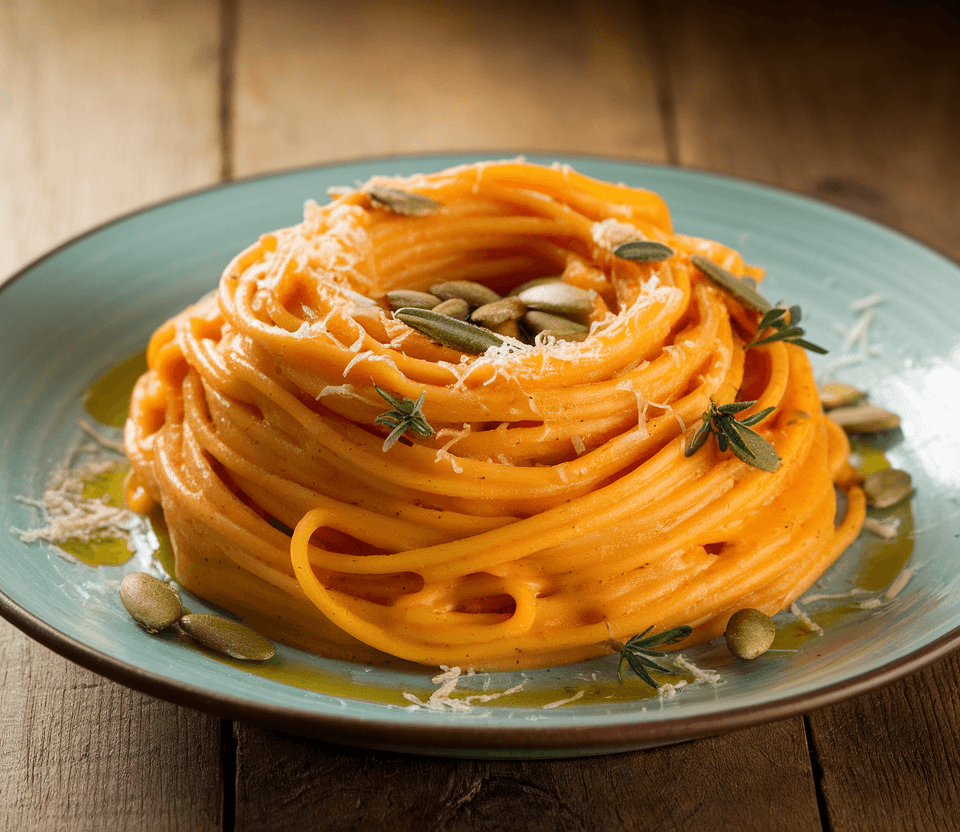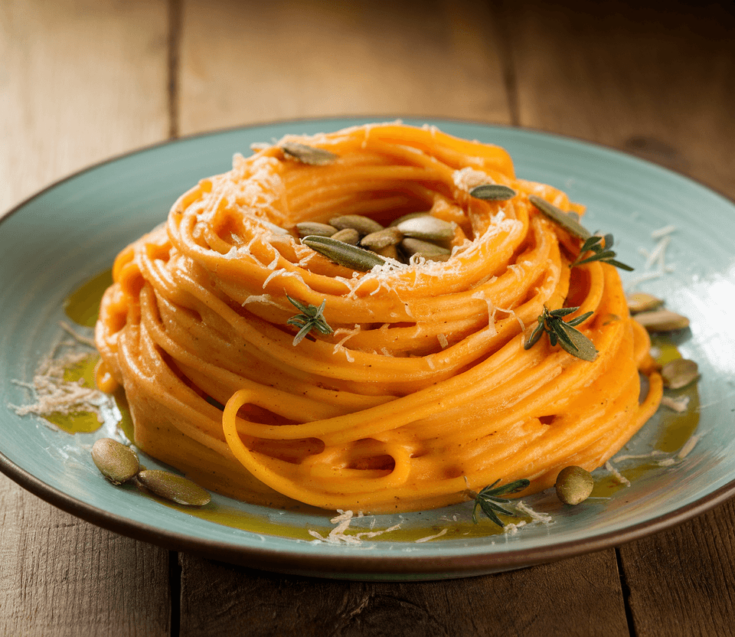Butternut Squash Spaghetti Sauce is a delightful and vibrant twist on traditional pasta sauces, combining the earthiness of roasted butternut squash with aromatic herbs and spices. This creamy, velvety sauce not only packs a punch of flavor but also offers a nutrition boost, making it a perfect choice for weeknight dinners or special occasions. The natural sweetness of the squash complements the savory notes, creating a dish that’s sure to please both vegetarians and meat-lovers alike.

Why You Will Love This Recipe
You will fall in love with this butternut squash spaghetti sauce recipe for several reasons. First, it’s packed with flavor—sweet yet savory, creamy without the heavy cream. Second, it’s incredibly easy to prepare; with minimal chopping and cooking time, you can have a wholesome meal ready in under an hour. Plus, this recipe is perfect for those following a vegetarian or vegan lifestyle, as it’s naturally plant-based and gluten-free when served with the right pasta. You can feel good about indulging in this comforting dish!
Tips and Tricks
To make this butternut squash spaghetti sauce even easier and more flavorful, here are some tips and tricks:
1. Roast the Squash: Roasting the butternut squash enhances its sweetness and depth of flavor. Don’t skip this step!
2. Use Fresh Herbs: Fresh sage or thyme will elevate the flavor profile of your sauce compared to dried herbs.
3. Blend for Creaminess: For a smoother sauce, use an immersion blender or a regular blender after cooking. If using a regular blender, let the mixture cool slightly before blending.
4. Pasta Water Magic: Reserve a cup of pasta cooking water. Adding a bit to the sauce can help adjust the consistency and enhance flavor.
Common Mistakes to Avoid
Here are some common mistakes to avoid when making your butternut squash spaghetti sauce:
1. Overcooking the Squash: Keep an eye on the roasting time. Overcooked squash can lead to a mushy sauce.
2. Neglecting Seasoning: Be generous with salt and pepper. A little seasoning goes a long way in elevating the dish.
3. Skipping the Cheese: If not vegan, adding a sprinkle of Parmesan cheese at the end can add a delicious umami flavor.
4. Not Blending Enough: If the sauce is too chunky for your liking, blend it further for a creamier texture.
Make Ahead Tips
To save time during busy weeknights, consider these make-ahead tips:
1. Prep the Squash: Peel and cube the butternut squash a day in advance and store it in an airtight container in the fridge.
2. Make the Sauce Ahead: You can prepare the entire sauce a day or two in advance. Store in the refrigerator and reheat when ready to serve.
3. Store Cooked Pasta: Cooked pasta can be stored separately in the fridge for up to 3 days. Just toss it with a little olive oil to prevent sticking.
Recipe Variations
This butternut squash spaghetti sauce recipe is versatile! Here are some variations to try:
1. Add Protein: Stir in cooked chickpeas or lentils for a heartier dish.
2. Spice it Up: Add a pinch of red pepper flakes for some heat or a dash of nutmeg for warmth.
3. Change the Squash: Substitute butternut squash with pumpkin or sweet potato for a different flavor.
4. Creamy Version: Stir in some coconut milk or heavy cream for a richer sauce.

How to Serve
Serve this butternut squash spaghetti sauce over your favorite pasta—spaghetti, penne, or even zucchini noodles work wonderfully. Top with fresh grated Parmesan cheese, a drizzle of olive oil, and a sprinkle of fresh herbs for a pop of color and flavor. For a beautiful presentation, serve in a shallow bowl, garnished with toasted pumpkin seeds or pine nuts for added crunch.
Pairing Suggestions
To complement your butternut squash spaghetti, consider these pairing suggestions:
- Wine: A glass of Chardonnay or a light Pinot Noir pairs beautifully with the sweetness of the sauce.
- Cocktail: A refreshing gin and tonic with a slice of lemon can be a great palate cleanser.
- Side Dishes: Pair with a simple arugula salad dressed with lemon vinaigrette for a bright contrast or garlic bread for a comforting touch.
- Desserts: End your meal with a light apple crumble or pumpkin pie for a seasonal treat.
How to Store
To store leftovers:
1. Refrigerator: Store any leftover sauce and pasta in separate airtight containers in the fridge for up to 4 days.
2. Freezing: The sauce freezes well! Portion it into freezer-safe containers or bags and store for up to 3 months. Thaw overnight in the fridge before reheating.
3. Reheating: Gently reheat the sauce in a saucepan over low heat, adding a splash of water or broth if it’s too thick. For pasta, heat in the microwave or in a pot with a little water.
Equipment Needed
You will need the following equipment for this recipe:
- Baking Sheet: For roasting the butternut squash.
- Blender/Immersion Blender: To puree the sauce to your desired consistency.
- Large Pot: For cooking the spaghetti.
- Cutting Board and Knife: For chopping the squash and herbs.
If you don’t have a blender, you can use a potato masher for a chunkier sauce.
Dietary Adaptations
To adapt this recipe for dietary restrictions:
- Vegan: Omit cheese or use nutritional yeast for a cheesy flavor.
- Dairy-Free: Use coconut milk or any dairy-free cream alternative.
- Nut-Free: This recipe is naturally nut-free, but always check any additional toppings or sides for allergens.
Seasonal Adaptations
Consider these seasonal adaptations:
- Fall/Winter: Use fresh sage, thyme, or rosemary to complement the butternut squash.
- Spring/Summer: Add fresh tomatoes or zucchini to lighten the sauce and incorporate seasonal produce.
Cost Breakdown
The estimated cost for this dish is approximately $10-12 for 4 servings, making it around $2.50-3.00 per serving. To keep costs down, consider using frozen butternut squash or substituting with other seasonal vegetables.
Kitchen Hacks
Here are some kitchen hacks to make your cooking experience smoother:
1. Easier Squash Prep: Microwave the butternut squash for 2-3 minutes before peeling to soften the skin, making it easier to cut.
2. Quick Herb Chopping: Use kitchen scissors to snip fresh herbs directly into your sauce for quick and easy chopping.
Recipe FAQs
1. Can I use canned butternut squash? Yes, but for the best flavor and texture, fresh or frozen squash is recommended.
2. How long should I cook the spaghetti? Follow package instructions, typically around 8-12 minutes for al dente.
3. What can I substitute for pasta? Zucchini noodles, spaghetti squash, or whole grain pasta make great alternatives.
Butternut Squash Spaghetti Sauce

Butternut Squash Spaghetti Sauce is a delightful and vibrant twist on traditional pasta sauces, combining the earthiness of roasted butternut squash with aromatic herbs and spices. This creamy, velvety sauce not only packs a punch of flavor but also offers a nutrition boost, making it a perfect choice for weeknight dinners or special occasions.
Ingredients
- 1 medium butternut squash (about 2-3 cups cubed)
- 2 tablespoons olive oil
- Salt and pepper, to taste
- 1 small onion, diced
- 3 cloves garlic, minced
- 1 teaspoon fresh sage, chopped (or ½ teaspoon dried sage)
- 1 teaspoon fresh thyme, chopped (or ½ teaspoon dried thyme)
- ½ cup vegetable broth
- 1 cup coconut milk (or heavy cream for non-vegan)
- 12 oz spaghetti (or pasta of choice)
- Grated Parmesan cheese, for serving (optional)
Instructions
- Preheat your oven to 400°F (200°C).
- Peel and cube the butternut squash, then toss it with 1 tablespoon of olive oil, salt, and pepper. Spread on a baking sheet and roast for 25-30 minutes until tender and caramelized.
- In a large pot, heat the remaining olive oil over medium heat. Add the diced onion and sauté until translucent, about 5 minutes. Add the minced garlic and cook for an additional minute until fragrant.
- Once the squash is roasted, add it to the pot along with the herbs and vegetable broth. Stir to combine and simmer for 5 minutes.
- Using an immersion blender, blend the mixture until smooth. Alternatively, transfer to a blender and blend in batches, then return to the pot.
- Stir in the coconut milk (or cream) and simmer for another 5 minutes. Adjust seasoning as needed.
- Meanwhile, cook the spaghetti according to package instructions. Drain and reserve some pasta water.
- Combine the cooked spaghetti with the sauce, adding reserved pasta water to reach desired consistency.
- Serve hot, garnished with Parmesan cheese and fresh herbs if desired.
Nutrition Information
Yield
4Serving Size
1Amount Per Serving Calories 337Total Fat 20gSaturated Fat 12gTrans Fat 0gUnsaturated Fat 7gCholesterol 1mgSodium 194mgCarbohydrates 36gFiber 3gSugar 3gProtein 7g
Dinnerfocus.com, occasionally offers nutritional information for recipes contained on this site. This information is provided as a courtesy and is an estimate only. This information comes from online calculators. Although allchickenrecipes.com attempts to provide accurate nutritional information, these figures are only estimates.
Final Thoughts
In conclusion, this butternut squash spaghetti sauce recipe is not just a delicious meal; it’s a celebration of fall flavors and comfort food. With its creamy texture and delightful sweetness, it’s sure to become a family favorite. Whether you’re cooking for yourself or entertaining guests, this dish is both impressive and easy to make. Enjoy the process, and don’t forget to customize it to your liking! Happy cooking!
